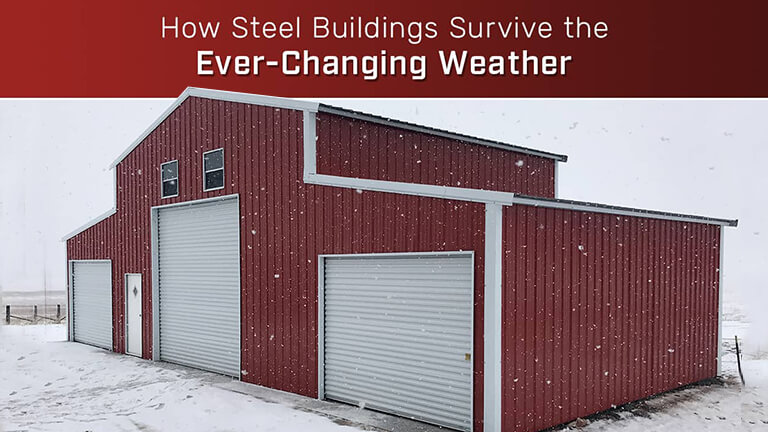How Steel Buildings Survive the Ever-Changing Weather


The steel-building trend is gaining wind fast, and it’s for a good reason – steel offers the perfect balance between sturdiness and lightweight in building construction. Steel structures last long and overcome the harshest weather conditions. It’s no coincidence that even earthquake-resistant skyscrapers are steel-made!
It comes as no surprise, therefore, that steel buildings have become the number one choice in America. In 2017, more than 45% of structural framing in the U.S. was steel, with non-residential and multi-storey construction accounting for over 37% of the overall demand for structural steel. We haven’t even touched on the numerous residential market shares of various prefab steel buildings such as garages, carports, utility storages, and homes. And the figures have only risen ever since!
So, how does steel beat weather uncertainties to win the heart of the construction industry, and how do you know it is the right material for your region? Read on to find out.
Not all regions face the same weather conditions – but you already knew that. Your area determines the probable disasters, hence the kind of structure you want to erect. For instance, what snow loads do a Hawaiian got to worry about? Yet you might end up feeling sorry if you lived in Vermont or Maine and failed to account for snow in your steel building. Knowing your weather is crucial to not only buying the right steel structure but also avoiding overpaying for qualities that you might never need.
Most blizzards arise from Nor’Easters – storms that travel up the American east coast. The northern areas especially experience screeching winds during snowstorms. This mixture of wind and snow often travels at no less than 35 mph and could be devastating to weak buildings that have poor anchorage. If you come from blizzard-prone regions, you want your steel building firmly anchored to the foundation. High-quality steel with base molding and closure strips are also ideal for preventing moisture from penetrating when the snow hits.
The U.S. battles approximately 1,200 tornadoes each year, making it by far the most tornado-prone country. The mid-section of the continent, known as the Tornado Alley, is especially notorious. Some tornado winds reach up to 300 mph, which spells trouble for many straight-walled structures.
Tornado-resistant prefab steel buildings come with a continuous load path. That is, a series of reinforcements holding every structural element together right from the roof to the foundation, akin to a chain. Additionally, each arch overlaps the next and is secured tightly with bolts. Then, the whole unit is firmly attached to the foundation.
Hurricanes are notorious for inflicting damage through high-velocity straight-line winds (punches through the building envelope), flooding, and tornados that spawn from the storm system. Hurricane-resistant metal buildings must have a sturdy structural frame, which makes steel the ideal choice. It has a stronger strength-to-weight ratio than any conventional material.
What’s more, pre-engineered steel buildings come with strong bolted, screwed, or riveted connections that resist the lifting force, unlike the nails in wooden structures. With a building made of steel and a few tweaks in the design – such as maintaining a lower profile, less steep roofs, and fewer openings – you could increase your probability of surviving tropical storms. Installation of impact-resistant doors and windows is also advisable as it will protect against debris.
Much like a hurricane, your best chances of reducing the risks associated with a typhoon is with steel structures. You want to ensure that your custom steel building has a continuous load path to overcome the lifting force. Also, strong lateral bracing will defend against sideways wind pressure. Hardened windows and doors will resist penetration by debris. Lastly, water-tight and water-shedding details will provide resistance against penetration by water and rain.
Earthquakes move the ground almost like the ripple effect that results from throwing a pebble in the water. In a few instances, however, it could be a single sudden movement. The land could move up and down, side to side, or both, which makes designing an earthquake-resistant building quite the hassle. Although it is almost impossible to build a structure that will resist all types of earthquakes 100%, we can get pretty close by using steel.
It offers the highest flexibility, allowing the structure to bend considerably without breaking. Moreover, its high strength-to-weight ratio means that we can design lighter structures. With this reduced weight, the building can withstand more side sway without collapsing.
We’ve all heard the science behind it – lightning is an electrostatic discharge and is, therefore, attracted to metal. Consequently, some might question the safety of a metal building during a storm. But science does it again! When lightning strikes, a professionally engineered construction disperses the heat and electricity into the ground. As you may already know, the earth has an infinite affinity for electrons, which means that it will take up all the charge, leaving all that’s inside the steel building safe.
No one needs much convincing about a prefab steel building’s ability to withstand flames. Steel does not catch fire. Even if things were burning inside the building, it takes no less than 2,500o F to melt steel. Yet an average house fire burns at between 1,000 to 2,000 degrees, depending on the combustible materials present. However, it is still advisable to have fire extinguishing equipment around because all building structural elements degrade in strength when subjected to long periods of heat.
Steel has a combination of various impressive attributes – like ductility, high strength-to-weight ratio, fire resistance, high tensile strength, and resistance to warping. All these features enable us to apply steel in the construction of buildings that can withstand a wide range of weather phenomena. Talk of blizzards, hurricanes, tornadoes, earthquakes, snow loads, and lightning, among others.
Not forgetting, prefab steel buildings are fast and easy to install, fully customizable to your taste, galvanized to withstand moisture, and affordable. You could even buy steel building kits and get your DIY on, conveniently cutting on costs while having some fun. Steel structures are becoming the standard of the construction industry!
Are you interested in going steel on your next building? Think Steel Carports, for the highest-quality steel structures in the industry. Steel Carports prides being America’s top dealer of steel buildings, offering its customers the best-quality materials, fast deliveries at no charge, exceptional warranties, and flexible payment options on metal buildings. Armed with a highly qualified and experienced team of building specialists, our steel building services are simply unparalleled.
Contact us now at (833) 647-8335 to get a free quote or consult our building specialists and get started on designing your dream steel building.
Let our experts help you get the steel building you need.